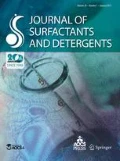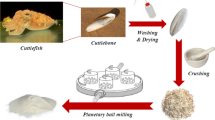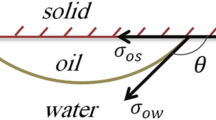Abstract
The primary objective of this work was to understand the dominant mechanism(s) of alkali-surfactant-polymer (ASP) flooding in enhancing heavy oil recovery. Chemical formulations were first optimized based on phase behavior studies. The data indicated that alkali and surfactant created a synergistic effect at the oil/water interface, which further decreased the interfacial tension (IFT) and improved the emulsification. However, it was also found that the addition of alkali was detrimental to the viscous properties of the chemical systems and caused the ultimate oil recovery to decrease. In other words, the macroscopic sweep efficiency as a result of viscosity was the primary factor determining the overall recovery of heavy oil followed by emulsification, which was verified by the phase behavior of the effluent. Based on the experimental results, we found that for this targeted heavy oil reservoir, surfactant-polymer (SP) flooding was more appropriate than ASP flooding and it was not necessary to decrease the IFT to the ultralow level (10−3 mN/m) using alkali. Through chemical flooding, the incremental oil recovery was increased up to 27% of original oil in place, indicating the potential of this technique in heavy oil reservoirs.













Similar content being viewed by others
References
Gao CH (2011) Advances of polymer flood in heavy oil recovery. Paper SPE 150384 presented at SPE International Heavy Oil Conference and Exhibition, December 12–14, Kuwait City, Kuwait.
Miller KA (2005) State of the Art of Western Canadian Heavy Oil Water Flood Technology. Paper PETSOC-2005-251 presented at Canadian International Petroleum Conference, Jun 7–9, Calgary, Alberta.
Hoang VT. High-mobility-ratio waterflood performance prediction: challenges and new insights. SPE Reservoir Eval Eng. 2008;11:186–96.
Dong M, Ma S, Qiang L. Enhanced heavy oil recovery through interfacial instability: a study of chemical flooding for Brintnell heavy oil. Fuel. 2009;88:1049–56.
Liu Q, Dong M, Ma S, Tu Y. Surfactant enhanced alkaline flooding for Western Canadian heavy oil recovery. Colloids Surf A Physicochem Eng Aspect. 2007;293:63–71.
Wei B, Romero-Zeron L, Rodrigue D. Evaluation of two new self-assembly polymeric systems for enhanced heavy oil recovery. Ind Eng Chem Res. 2014;53:16600–11.
Pei H, Zhang G, Ge J, Jin L, Ding L. Study on the variation of dynamic interfacial tension in the process of alkaline flooding for heavy oil. Fuel. 2013;104:372–8.
Dong M, Liu Q, Li A. Displacement mechanisms of enhanced heavy oil recovery by alkaline flooding in a micromodel. Particuology. 2012;10:298–305.
Pei H, Zhang G, Ge J, Jin L, Liu X. Analysis of microscopic displacement mechanisms of alkaline flooding for enhanced heavy-oil recovery. Energy Fuels. 2011;25:4423–9.
Olajire AA. Review of ASP EOR (alkaline surfactant polymer enhanced oil recovery) technology in the petroleum industry: prospects and challenges. Energy. 2014;77:963–82.
El-Batanoney M, Abdel-Moghny T, Ramzi M. The effect of mixed surfactants on enhanacing oil recovery. J Surfactants Deterg. 1999;2:201–5.
Nguele R, Sasaki K, Salim SA, Sugai Y. Physicochemical and microemulsion properties of dimeric quaternary ammonium salts with trimethylene spacer for enhanced oil recovery. Colloid Polym Sci. 2015;293:1–11.
Bera A, Mandal A, Guha BB. Synergistic effect of surfactant and salt mixture on interfacial tension reduction between crude oil and water in enhanced oil recovery. J Chem Eng Data. 2013;59:89–96.
Wei B, Romero-Zeron L, Rodrigue D. Oil displacement mechanisms of viscoelastic polymers in enhanced oil recovery (EOR): a review. J Petrol Explor Prod Technol. 2013;4:13–121.
Gao S, Gao Q (2010) Recent progress and evaluation of ASP flooding for EOR in Daqing oil field. Paper SPE 127714 presented at SPE EOR Conference at Oil & Gas West Asia, April 11–13, Muscat, Oman.
Kumar R, Mohanty KK (2010) ASP flooding of viscous oils. Paper SPE 135265 presented at SPE Annual Technical Conference and Exhibition, September 19–22, Florence, Italy.
Zhang J, Ravikiran R, Freiberg D, Thomas CP (2012) ASP formulation design for heavy oil. Paper SPE 153570 presented at Improved Oil Recovery Symposium, April 14–18, Tulas, klahoma.
Avwioroko J, Taiwo O, Mohammed I, Dala J, Olafuyi O. Mohammed, J. Dala, Olafuyi O (2014) A laboratory study of ASP flooding on mixed wettability for heavy oil recovery using Gum Arabic as a polymer. Paper SPE 172400 presented at SPE Nigeria Annual International Conference and Exhibition, August 5–7, Lagos, Nigeria.
Sedaghat M, Mohammadzadeh O, Kord S, Chatzis I (2015) Pore-level experimental investigation of ASP flooding to recover heavy oil in fractured five-spot micromodels. Paper SPE 174290 presented at EUROPEC 2015, June 1–4, Madrid, Spain.
Pu W, Jiang F, He Y, Wei B, Tang Y. Synthesis of a novel comb micro-block hydrophobically associating copolymer for Ca2+/Mg2+ resistance. RSC Adv. 2016;6:43634–7.
Wei B. Flow characteristics of three enhanced oil recovery polymers in Porous Media. J Appl Polym Sci. 2015. doi:10.1002/app.41598.
Ge J, Feng A, Zhang G, Ping J, Pei H, Li R, Xin F. Study of the factors influencing alkaline flooding in heavy-oil reservoirs. Energy Fuels. 2012;26:2875–82.
Rudin J, Wasan DT. Mechanisms for lowering of interfacial tension in alkali/acidic oil systems 1. Experimental studies. Colloids Surf A Physciochem Eng Aspect. 1992;68:67–79.
Qiao W, Cui Y, Zhu Y, Cai H. Dynamic interfacial tension behaviors between Guerbet betaine surfactants solution and Daqing crude oil. Fuel. 2012;102:746–50.
Reichenbach-Klinke R, Langlotz B, Wenzke B, Spindler C, Brodt G (2011) Hydrophobic associative copolymer with favorable properties for the application in polymer flooding. Paper SPE 141107 presented at SPE international Symposium on Oilfield Chemistry, April 11–13, The Woodlands, Texas.
Reichenbach-Klinke R, Stavland A, Langlotz B, Wenzke B, Brodt G (2013) New insights into the mechanism of mobility reduction by associative type copolymers. Paper SPE 165225 presented at SPE Enhanced Oil Recovery Conference, July 2–4, Kuala Lumpur, Malaysia.
Wei B, Romero-Zeron L, Rodrigue D. Novel self-assembling polymeric system based on a hydrophobic modified copolymer: Formulation, rheological characterization, and performance in enhanced heavy oil recovery. Polym Adv Technol. 2014;25:732–41.
Seright RS, Fan T, Wavrik K, Balaban RDC. New insights into polymer rheology in porous media. SPE J. 2011;16:35–42.
Seright RS, Fan T, Wavrik K, Wan H, Gaillard N, Favero C. Rheology of a new sulfonic associative polymer in porous media. SPE Reservoir Eval Eng. 2011;14:726–34.
Kjoniksen AL, Beheshti N, Kotlar HK, Zhu K, Bo N. Modified polysaccharides for use in enhanced oil recovery applications. Eur Polym J. 2008;44:959–67.
Kumar R, Dao EK, Mohanty KK (2010) Emulsion flooding of heavy oil. Paper SPE 129914 presented at SPE Improved Oil Recovery Symposium, April 24–28, Tulsa, Oklahoma, USA.
Acknowledgements
The authors wish to acknowledge the financial support provided by the National Key Basic Research Program of China (2015CB250904) and PetroChina Innovation Foundation (2015D-5006-0212). The valuable comments made by the anonymous reviewers are also sincerely appreciated.
Author information
Authors and Affiliations
Corresponding authors
About this article
Cite this article
Wei, B., Lu, L., Pu, W. et al. From Phase Behavior to Understand the Dominant Mechanism of Alkali-Surfactant-Polymer Flooding in Enhancing Heavy Oil Recovery. J Surfact Deterg 20, 355–366 (2017). https://doi.org/10.1007/s11743-016-1920-x
Received:
Accepted:
Published:
Issue Date:
DOI: https://doi.org/10.1007/s11743-016-1920-x




